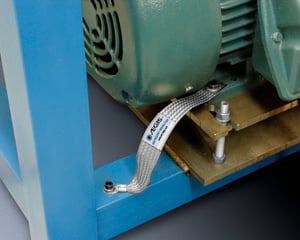Q1. What exactly should I attach a high-frequency grounding strap to? They come in 1- and 2-foot lengths, and that's often not long enough to reach the drive.

A1. It's best to bond the motor back to the drive. If you can't reach it, the next best thing is to bond the motor frame to the frame of the driven equipment or another conductor bonded to the equipment. The reason is, if the motor frame is not well bonded to the drive, you can get what's called rotor ground current (see Question 1 here). Rotor ground current damages bearings in both the motor AND the driven equipment. If you bond the frames of motor and load, you give that current a low-impedance path that doesn't go through any bearings.
Eaton, the drive manufacturer, suggests another use, too. Using metal conduit for the motor power cables, you can bond the motor frame to the conduit with one HFGS, and at the other end, bond the conduit to the VFD ground. This approach has the added benefit of confining the stray current from the frame, which could otherwise wander through the facility causing interference.
Q2. In motors under 100 hp, do you not need a grounding strap?
A2. No, we recommend a grounding strap for all motors on drives, regardless of size. Rotor ground current, just like shaft voltage discharge, can occur in motors of all sizes.
With that said, you will probably be alright if you have proper VFD cable: You want one or three ground conductors and usually a braided wire or foil shielding. (Not just THHN cable.) Good cable is the best way to protect against rotor ground current because it gives a very low impedance path back to the drive. High-frequency current coming off the motor frame doesn't care about "ground" per se; it is trying to get back to the drive. Getting this stray current right back to the drive has the added benefit, as above, of preventing it from interfering with other electronics in the facility.
Q3. Does the high-frequency grounding strap double as a grounding conductor for the motor frame?
A3. No, the AEGIS® HFGS is not a ground-fault device. You still need a safety ground. The HFGS can handle a few tens of amps, but if a motor phase shorted to the frame, you wouldn't want to rely on it to carry that level of current.
AEGIS Shaft Grounding Rings have a 2-year extended warranty against bearing fluting damage. No other form of shaft grounding offers a warranty like this.
To learn more about AEGIS shaft grounding and best practices for electrical bearing protection, sign up for a training. We offer monthly live training webinars, and we can also visit your facility to review your exact application.



